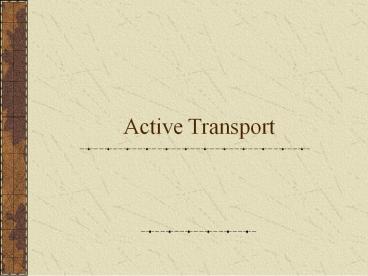Active Transport - PowerPoint PPT Presentation
Title:
Active Transport
Description:
Active Transport – PowerPoint PPT presentation
Number of Views:345
Avg rating:3.0/5.0
Title: Active Transport
1
Active Transport
2
Active Transport
- Cellular energy is used to to transport
substances across the membrane against a
concentration gradient - Energy is derived from splitting ATP
3
Pumps
- A transporter protein that uses energy from
splitting ATP to change shape and carry a
substance across a cellular membrane against its
concentration gradient
4
Substances Transported
- Na
- K
- H
- Ca
- I-
- Cl-
5
Sodium-Potassium Pump
- Expels Na from the cell, brings K into the cell
- Acts as an enzyme to split ATP
- Used to maintain a low Na concentration in the
cytosol by pumping Na into the extracellular
fluid
6
Continuous Operation
- Na and K slowly leak back across the membrane
down their gradients, so the pumps must
continuously move these ions back across the
membrane to maintain the concentration gradient.
7
Concentration Gradient
- The differing concentrations are crucial for
osmotic balance of the 2 fluids and also for the
ability of some cells to generate electrical
signals
8
(No Transcript)
9
(No Transcript)
10
Operation of the Sodium Potassium Pump
- 1. Three Na in the cytosol bind to the pump
protein - 2. Na binding triggers the splitting of ATP into
ADP plus a phosphate group which attaches to the
pump protein. This causes a change in the shape
of the pump protein - 3. Three Na are expelled into the extracellular
fluid
11
Operation of the Sodium Potassium Pump
- 4. The changed shape allows 2 K in the
extracellular fluid to bind to the protein - 5. The binding of the K causes the phosphate
group to be released which causes the pump
protein to return to its original shape - 6. As the pump protein returns to its original
shape, it releases the 2 K into the cytosol. - The pump protein is then ready to bind Na and
the cycle can repeat
12
Malfunctions of Transporters
- Drugs some turn off ATP production which would
stop active transport of substances throughout
the body - Cystic Fibrosis a defective gene causes an
abnormal Cl- transporter. There is a failure to
secrete adequate amounts of Cl- resulting in
extremely thick mucus secretions that result in
obstruction and infection.
13
Transport in Vesicles
- Vesicle a small sac formed by the budding off
from an existing membrane
- Movement of vesicles requires energy supplied by
ATP.
14
ENDOCYTOSIS
- Materials move into a cell is a vesicle formed
from the plasma membrane - Phagocytosis
- Bulk Phase Endocytosis
15
Phagocytosis
- Large solid particles (like whole cells) are
taken in by the cell. - The particle binds to the plasma membrane
receptor, the cell extends projections called
pseudopods that surround the particle, then the
membranes fuse to create a vesicle in the
cytoplasm.
16
(No Transcript)
17
- Any undigested material remain indefinitely in a
vesicle called a residual body - Phagocytosis occurs only in special cells called
phagocytes - They are specialized cells used to engulf and
destroy bacterial and other foreign substances - These cells include certain white blood cells and
macrophages. - Phagocytosis is one of the bodys defense
mechanisms against disease
18
Bulk Phase Endocytosis
- Cells take up vesicles containing tiny droplets
of extracellular fluid and any solutes dissolved
in that fluid - The vesicle detaches from the membrane and enters
the cytosol - The vesicle fuses with a lysosome where enzymes
digest the solutes into smaller molecules
19
(No Transcript)
20
Exocytosis
- Results in secretion materials exiting the cell
- Secretory cells give off digestive enzymes,
hormones, mucus or other secretions - Nerve cells give off neurotransmitters
21
Secretory Vesicle
- Vesicle containing substance to be secreted forms
in the cytosol, fuses with the plasma membrane
then releases the contents into the extracellular
fluid
22
23
CHECKPOINT
- What is the key difference between active and
passive transport? - Briefly compare/contrast facilitated diffusion
and active transport through a membrane pump - Describe the process of phagocytosis.
- Name one way phagocytosis helps to maintain
homeostasis.































